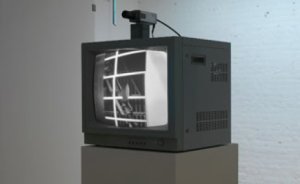
Peter Campus is a pioneer of video art who experimented with the medium in the 1970s alongside other notable artists Bill Viola, Bruce Nauman, and Joan Jonas. Video represented a new frontier, one that allowed artists to expand upon common artistic concerns of the era, including minimalism, performance, and conceptual art Campus pursued many directions, and created both large-scale projections and a series of little-seen installation works that employ live video feeds, of which Kiva (1971) is one. Campus experimented with closed circuit cameras not with an interest in surveillance and control, but rather because they were the ideal tools for producing situations of interactive engagement between viewer and image.
Kiva–the title refers to a kind of ceremonial room used by Native Americans of the Southwest for ritual and spiritual ceremonies–comprises a monitor with a closed circuit camera mounted on top; the lens is pointed directly at the viewer of the monitor, but the camera's view is restricted and manipulated by the placement of suspended mirrors. The camera shoots through a hole in one mirror to the surface of the other, both constantly shifting in relation to each other as they turn like a mobile. The mirrors fragment and multiply the image, allowing the camera to take in aspects of the room, the viewer, and the eye of the camera itself.
This project is made possible by the UMMA Director's Discretionary Fund.
Kiva–the title refers to a kind of ceremonial room used by Native Americans of the Southwest for ritual and spiritual ceremonies–comprises a monitor with a closed circuit camera mounted on top; the lens is pointed directly at the viewer of the monitor, but the camera's view is restricted and manipulated by the placement of suspended mirrors. The camera shoots through a hole in one mirror to the surface of the other, both constantly shifting in relation to each other as they turn like a mobile. The mirrors fragment and multiply the image, allowing the camera to take in aspects of the room, the viewer, and the eye of the camera itself.
This project is made possible by the UMMA Director's Discretionary Fund.